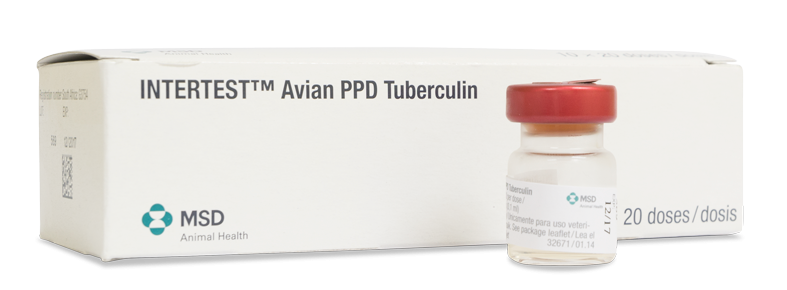Intertest® Avian PPD Tuberculin
Intertest® Avian PPD Tuberculin is used for diagnosis of avian tuberculosis and comparative tuberculin test in cattle and other domestic animals.
FOR ANIMAL USE ONLY

INTERTEST® Avian PPD Tuberculin
Reg. No. G3754 (Act 36/1947)
Namibia Reg. No. V07/24.9/374 [NS0]
INDICATIONS
Intertest® Avian PPD Tuberculin is used for diagnosis of avian tuberculosis and as a comparative tuberculin test in cattle and other domestic animals.
NOTE
Tuberculosis is a controlled disease in terms of the Animal Diseases Act (Act 35/1984). In terms of the act, it is stipulated that:
(1) Any occurrence or suspected occurrence of tuberculosis must be reported immediately to the local state veterinarian.
(2) A tuberculin test may be carried out only by a state veterinary officer, an authorised person or a veterinarian. All tuberculin test results must to be communicated in writing to the state veterinarian who is responsible for the determination of the disease status of an animal with regards to tuberculosis.
(3) Infected, suspect and contact animals shall be isolated, tested, marked and slaughtered as determined by the state veterinarian.
COMPOSITION
Intertest® Avian PPD Tuberculin is a purified protein derivative (PPD) of Mycobacterium avium strain D4 cultures. It contains no live bacteria.
1 mℓ of the solution contains 25 000 IU and a maximum of 0,5 % of phenol as preservative.
STORAGE INSTRUCTIONS
- Store between 2 °C and 8 °C in a refrigerator.
- Do not freeze.
- Store in the original package in order to protect from light.
- Protect from light.
- Do not use this veterinary medicinal product after the expiry date which is stated on the label.
- After broaching the vial, use immediately.
WARNINGS
- Withdrawal period: None
- Acutely sick animals are to be exempted from administration of Intertest® Avian PPD Tuberculin.
- In order to prevent inflammatory reactions, the test should be administered aseptic.
- In case of infections with mycobacteria of other species, non-specific reactions may result. In order to differentiate between avian tuberculosis and bovine tuberculosis a comparative tuberculosis test should be performed.
- The comparative test for bovine tuberculosis should be administered at the earliest 6 weeks after previous administration of Intertest® Avian PPD Tuberculin to prevent false results. Similar waiting periods should be observed before a post-examination in poultry.
- To prevent false negative results, animals which are treated, e.g. with corticosteroids or ACTH (Adrenocorticotropic hormone), are to be exempted from testing with Intertest® Avian PPD Tuberculin. After the administration of live viral vaccines false negative results cannot be ruled out.
- On rare occasions latently infected animals or sensitised animals may show allergic or anaphylactic reactions when injected with Intertest® Avian PPD Tuberculin.
- Do not mix this vaccine with any other vaccine or medication
- KEEP OUT OF REACH OF CHILDREN, UNINFORMED PERSONS AND ANIMALS.
- Although this product has been extensively tested under a large variety of conditions, failure thereof may ensue as a result of a wide range of reasons. If this is suspected, seek veterinary advice and notify the registration holder.
PRECAUTIONS
- Observe aseptic precautions. Ensure that all equipment (containers, syringes and needles) is clean and sterile prior to and during use.
- Do not use disinfectants or antiseptics to sterilise any equipment.
- Do not eat, drink or smoke whilst handling the product.
- Dispose of any containers, disposable equipment and any other waste after use, in accordance with National Environmental Management: Waste Act, 2008 (Act No. 59 of 2008) and do not reuse for any other purpose.
- Do not contaminate rivers, dams or any water sources with containers or waste.
DOSAGE AND DIRECTIONS FOR USE – USE ONLY AS DIRECTED
One dose of 0,1 mℓ contains 2 500 IU.
The correct placement of the injection is indicated by a pea-like swelling at the site of injection.
Comparative tuberculin test
- In bovines with suspect results, a comparative tuberculin test should be done with bovine and avian tuberculin simultaneously. This must be administered at the earliest, 6 weeks after a previous administration of tuberculin.
- The execution of the comparative tuberculin test follows in the same manner as the process of bovine tuberculin testing. The 2 intracutaneous injections should be undertaken either on one side (in that case bovine tuberculin aboveand avian tuberculin below) or on opposite sides of the body at corresponding positions (on the neck at the ridge of the shoulder blade). In the latter case the possible occurrence of clinical symptoms at the points of injection (specifically a parallel infection of the regional lymphatic nodes and lymphatic vessels) can be defined more clearly.
- 0,1 mℓ of bovine tuberculin with 5 000 IU and 0,1 mℓ avian tuberculin with 2 500 IU should be injected into a fold of skin. The points of injection are to be marked. This can be accomplished most practically, by shaving the skin in an area of approximately 8 to 10 cm in length and approximately 2 to 3 cm in width. In these areas no thickening should occur. At both points of injection, the thickness of the fold of the skin is to be measured (e.g. Hauptner-calliper) and noted. It is important to see to it that the tuberculin is injected strictly intradermal and not subcutaneously. In addition, care should be taken that no vaccine flows out of the injection site. In order to check the correct positioning of the intradermal injection, it has proven prudent to check the point of injection with the tip of the finger for the presence of a pea-like swelling.
- The result of the tuberculin tests should not be read and evaluated earlier than 72 hours and not later than 96 hours after the injection of the tuberculin. During the reading, particular note should be taken of the careful measuring of the thickness of the skin at the point of injection. The evaluation of the tuberculin reaction follows through comparison of the reactions obtained with bovine and avian tuberculin. The evaluation is to be executed taking cognisance of the clinical symptoms as presented at the point of injection, i.e. pain, a doughy consistence, exudation and necrosis, particularly however on the basis of the actual precisely measured increase in thickness of the skin. An evaluation undertaken solely on the basis of palpation is in no way sufficient.
Interpretation of reactions
The interpretation of reactions shall be based on clinical observations and the recorded increase in skin-fold thickness at the sites of injection 72 hours after injection of tuberculin.
The following key is to be used as a guideline for evaluation:
| Bovine minus avian tuberculin | Thickness of skin (difference in mm) | Diagnosis |
| Positive result | More than 4,0 mm | Positive |
| 2,1 to 4,0 mm | Suspect | |
| Up to 2,0 mm | Negative | |
| Negative result | Increase which is less than or equal to the reaction at the site of avian injection and absence of clinical signs. | Negative |
- If clear clinical symptoms occur, even with a very small margin in bovine tuberculin, the presence of a bovine tuberculosis infection is possible.
- Any retest should be performed in accordance with the local or national control programme standard.
PRESENTATION
Cartonbox with glass vials each containing 2 mℓ (20 doses). The vials are closed with a rubber stopper and sealed with an aluminium cap.
Cartonbox with glass carpules each containing 1,8 mℓ (18 doses).
Not all pack sizes may necessarily be marketed.
REGISTRATION HOLDER
Intervet South Africa (Pty) Ltd.
20 Spartan Road, Spartan
1619, RSA
Tel: +27 (0) 11 923 9300
E-mail: msdahza@msd.com
www.msd-animal-health.co.za
DATE OF PUBLICATION OF THIS PACKAGE INSERT
3 April 2007
